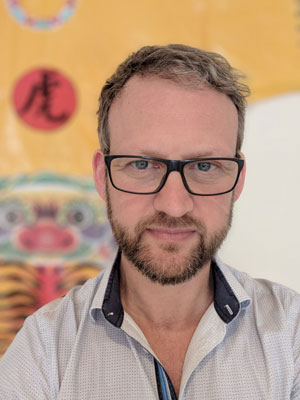INTERVIEW: MARC GLÖDE
Marc Gloede is a curator, critic and film scholar. His work focuses on the relationship between images, technology, space, the body, and the dynamics between art, architecture and film. He was senior curator of Art Film, Art Basel’s film programme (2008-14) and has curated exhibitions including STILL/MOVING/STILL — The History of Slide Projection in the Arts (Knokke / Belgium). He authored the book Farbige Lichträume / Colored Space of Light (2014), was co-editor of Synästhesie-Effekte (2011), and was recently published in The Impossibility of Mapping [Urban Asia] (2020). He received his PhD at the Free University of Berlin and since 2017 is Assistant Professor and Co-Director of the MA in Museum Studies and Curatorial Practices at NTU ADM.
How did you start curating, and how do you define your curatorial work?
I started curating in the mid-1990s in Berlin. My own background at that time was very performance and film oriented. So, in a way, not the classical curatorial education in art history or even a curatorial programme. I collaborated with a lot of artists in Berlin and we were interested in experimenting with very different formats: various media, spaces, event forms. We were in a very privileged situation — Germany’s reunification had just happened, and so there was so much cheap space available in the city. People working in the arts were constantly opening up new spaces for limited time periods. For me, that initial environment was formative. I think in this kind of open situation, artists, film makers, performers, musicians, curators, etc., could be very experimental and innovative in relation to the spaces or budgets that were available. This is something that until today has a crucial impact on my curatorial practice — understanding and working within a specific environment, and creating something that is truly collaborative and also inspiring and challenging for the audience.
As someone who has worked in a wide range of environments ranging from Art Basel, NTU CCA, to the current show at the Objectifs Chapel Gallery, Progressive Disintegrations, how does your role as a curator change in each situation?
Well, these frames you have mentioned are all of course very different from each other. And yes – there are always very specific dynamics that you have to take in consideration and that you have to deal with e.g. different interests from artists, gallerists, certain local or regional discussions, spatial limitations, budgets… But then at the same time – no matter the frame you work in – there is always this somewhat banal, but continuous aspect of collaboration. We always take that aspect for granted – working together. But I think it is actually one of the key challenges these days. Understanding what collaboration means under different circumstances. Trying to be open, understanding, and able to change ideas (your own or that from others) along the way. It means to work not necessarily towards an envisioned idea or an end result, but to be more aware of and interested in the process. I think that was most important for me. Sounds banal, but it is crucial.
What do you look out for in a curatorial proposal?
When I think about curatorial works that have inspired me, one thing that all these exhibitions, programmes, biennales, etc., had in common was this moment of irritation. I know that in the English context irritation often has a more negative connotation. But for me there is something positive embedded in this idea. If an exhibition is irritating, there is something itchy (that disturbs?), something that doesn’t let you rest, or proceed in a usual manner. It might even drive you a bit crazy. But you can’t go on in a way that says: ok seen that, thank you, moving on. You can’t ignore that irritating feeling and this situation makes you go back again and again to the specific situation that has created this. The best exhibitions I have seen were somehow able to preserve this irritation and made me want to go back again and again. So – I guess that is something that I am always very interested in. Exhibitions and curatorial concepts that trigger me and push me to want to go back and think and experience.
Read our interview with fellow advisor Wang Ruobing here.
Apply for Curator Open Call here.
Deadline: 8 March 2021

